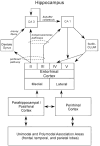An animal model of recognition memory and medial temporal lobe amnesia: history and current issues
- PMID: 20144894
- PMCID: PMC2975590
- DOI: 10.1016/j.neuropsychologia.2010.02.004
An animal model of recognition memory and medial temporal lobe amnesia: history and current issues
Abstract
The medial temporal lobe includes a system of anatomically connected structures that are essential for declarative memory (conscious memory for facts and events). A prominent form of declarative memory is recognition memory (the ability to identify a recently encountered item as familiar). Recognition memory has been frequently assessed in humans and in the experimental animal. This article traces the successful development of an animal model of human medial temporal lobe amnesia, which eventually identified the structures in the medial temporal lobe important for memory. Attention is given to two prominent behavioral paradigms (delayed nonmatching to sample and tests of spontaneous novelty preference).
Figures




References
-
- Aggleton JP. One-trial object recognition by rats. Quarterly Journal of Experimental Psychology. 1985;37B:279–294.
-
- Aggleton JP, Brown MW. Interleaving brain systems for episodic and recognition memory. Trends in Cognitive Science. 2006;10:455–463. - PubMed
-
- Aggleton JP, Hunt PR, Rawlins JNP. The effects of hippocampal lesions upon spatial and non-spatial tests of working memory. Behavioral Brain Research. 1986;19:133–146. - PubMed
-
- Ainge JA, Heron-Maxwell C, Theofilas P, Wright P, de Hoz L, Wood ER. The role of the hippocampus in object recognition in rats: examination of the influence of task parameters and lesion size. Behavioral Brain Research. 2006;167:183–195. - PubMed
Publication types
MeSH terms
Grants and funding
LinkOut - more resources
Full Text Sources

